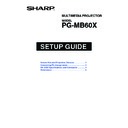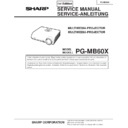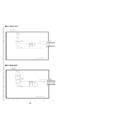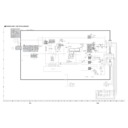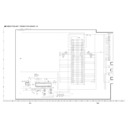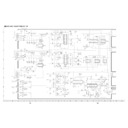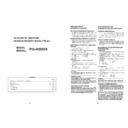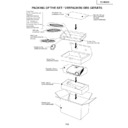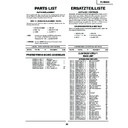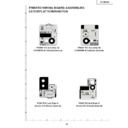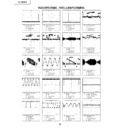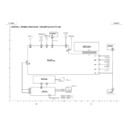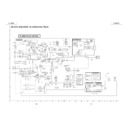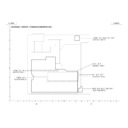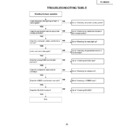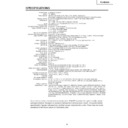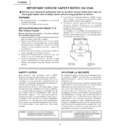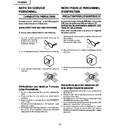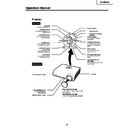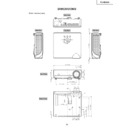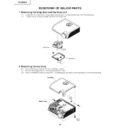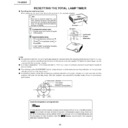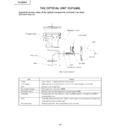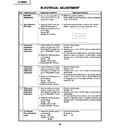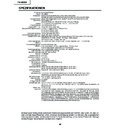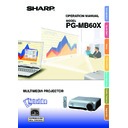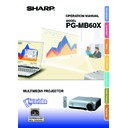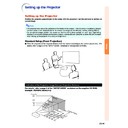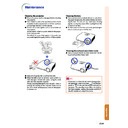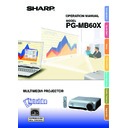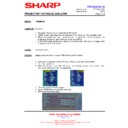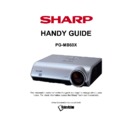Sharp PG-MB60X (serv.man29) User Manual / Operation Manual ▷ View online
MODEL
PG-MB60X
MULTIMEDIA PROJECTOR
SETUP GUIDE
Screen Size and Projection Distance ................... 2
Connecting Pin Assignments ................................ 3
RS-232C Specifications and Commands ............. 4
Dimensions ............................................................. 6
Connecting Pin Assignments ................................ 3
RS-232C Specifications and Commands ............. 4
Dimensions ............................................................. 6
-2
Picture (Screen) size
Projection distance [L]
Diag. [
χ]
Width
Height
Minimum [L1]
Maximum [L2]
250" (635 cm)
553 cm (218")
311 cm (123")
8.2 m (27' 0") 12.4 m (40' 8")
–61.1 cm (–24
5
/
64
")
225" (572 cm)
498 cm (196")
280 cm (110")
7.4 m (24' 3") 11.2 m (36' 7")
–55.0 cm (–21
43
/
64
")
200" (508 cm)
443 cm (174")
249 cm
(98")
6.6 m (21' 7")
9.9 m (32' 6")
–48.9 cm (–19
17
/
64
")
150" (381 cm)
332 cm (131")
187 cm
(74")
4.9 m (16' 2")
7.4 m (24' 5")
–36.7 cm (–14
14
/
32
")
133" (338 cm)
294 cm (116")
166 cm
(65")
4.4 m (14' 4")
6.6 m (21' 8")
–32.5 cm (–12
13
/
16
")
106" (269 cm)
235 cm
(92")
132 cm
(52")
3.5 m (11' 5")
5.3 m (17' 3")
–25.9 cm (–10
13
/
64
")
100" (254 cm)
221 cm
(87")
125 cm
(49")
3.3 m (10'10")
5.0 m (16' 3")
–24.5 cm
(–9
5
/
8
")
92" (234 cm)
204 cm
(80")
115 cm
(45")
3.0 m
(9'11")
4.6 m (15' 0")
–22.5 cm
(–8
55
/
64
")
84" (213 cm)
186 cm
(73")
105 cm
(41")
2.8 m
(9' 1")
4.2 m (13' 8")
–20.5 cm
(–8
3
/
32
")
72" (183 cm)
159 cm
(63")
90 cm
(35")
2.4 m
(7' 9")
3.6 m (11' 9")
–17.6 cm
(–6
15
/
16
")
60" (152 cm)
133 cm
(52")
75 cm
(29")
2.0 m
(6' 6")
3.0 m
(9' 9")
–14.7 cm
(–5
25
/
32
")
40" (102 cm)
89 cm
(35")
50 cm
(20")
1.3 m
(4' 4")
2.0 m
(6' 6")
–9.8 cm
(–3
55
/
64
")
Picture (Screen) size
Projection distance [L]
Diag. [
χ]
Width
Height
Minimum [L1]
Maximum [L2]
300" (762 cm)
610 cm (240")
457 cm (180")
9.1 m (29' 9") 13.7 m (44' 9")
–10.2 cm
(–4
1
/
64
")
250" (635 cm)
508 cm (200")
381 cm (150")
7.6 m (24' 9") 11.4 m (37' 4")
–8.5 cm
(–3
11
/
32
")
200" (508 cm)
406 cm (160")
305 cm (120")
6.0 m (19'10")
9.1 m (29'10")
–6.8 cm
(–2
43
/
64
")
150" (381 cm)
305 cm (120")
229 cm
(90")
4.5 m (14'10")
6.8 m (22' 5")
–5.1 cm
(–2
1
/
64
")
100" (254 cm)
203 cm
(80")
152 cm
(60")
3.0 m
(9'11")
4.6 m (14'11")
–3.4 cm
(–1
11
/
32
")
84" (213 cm)
171 cm
(67")
128 cm
(50")
2.5 m
(8' 4")
3.8 m (12' 6")
–2.9 cm
(–1
1
/
8
")
72" (183 cm)
146 cm
(58")
110 cm
(43")
2.2 m
(7' 2")
3.3 m (10' 9")
–2.4 cm
(–
31
/
32
")
60" (152 cm)
122 cm
(48")
91 cm
(36")
1.8 m
(5'11")
2.7 m
(8'11")
–2.0 cm
(–
51
/
64
")
40" (102 cm)
81 cm
(32")
61 cm
(24")
1.2 m
(4' 0")
1.8 m
(6' 0")
–1.4 cm
(–
17
/
32
")
Distance from the bottom of the image to
the lens center [H]
The formula for picture size and projection distance
[m/cm]
[m/cm]
[Feet/inches]
L1 (m) = 0.0302χ
L1 (ft) = 0.0302χ / 0.3048
L2 (m) = 0.0455χ
L2 (ft) = 0.0455χ / 0.3048
H (cm) = –0.034χ
H (in) = –0.034χ / 2.54
χ: Picture size (diag.) (in/cm)
L:
L:
Projection distance(m/ft)
L1: Minimum projection distance (m/ft)
L2: Maximum projection distance (m/ft)
H:
L2: Maximum projection distance (m/ft)
H:
Distance from the bottom of the image to the lens center (cm/in)
Note
• There may be an error of ± 3% in the above values.
• Values with a minus (–) sign indicate that the lens center is lower than the bottom of the image.
The formula for picture size and projection distance
[m/cm]
[m/cm]
[Feet/inches]
L1 (m) = 0.0329χ
L1 (ft) = 0.0329χ / 0.3048
L2 (m) = 0.04957χ
L2 (ft) = 0.04957χ / 0.3048
H (cm) = –0.24459χ
H (in) = –0.24459χ / 2.54
χ: Picture size (diag.) (in/cm)
L:
L:
Projection distance(m/ft)
L1: Minimum projection distance (m/ft)
L2: Maximum projection distance (m/ft)
H:
L2: Maximum projection distance (m/ft)
H:
Distance from the bottom of the image to the lens center (cm/in)
STRETCH Mode (16:9)
Distance from the bottom of the image to
the lens center [H]
Screen Size and Projection Distance
H
L
Side View
Screen
Lens center
The projection screen size varies according to the distance from the lens of the projector to the screen.
Install the projector so that projected images are projected onto the screen at the optimum size by referring
to the table below. Use the values in the table as a reference when installing the projector.
Install the projector so that projected images are projected onto the screen at the optimum size by referring
to the table below. Use the values in the table as a reference when installing the projector.
NORMAL Mode (4:3)
-3
RS-232C Terminal: 9-pin Mini DIN female connector
Pin No.
Signal
Name
I/O
Reference
1
Not connected
2
RD
Receive Data
Input
Connected to internal circuit
3
SD
Send Data
Output
Connected to internal circuit
4
Not connected
5
SG
Signal Ground
Connected to internal circuit
6
Not connected
7
RS
Connected to Pin 8
8
CS
Connected to Pin 7
9
Not connected
DIN-D-sub RS-232C adaptor: 9-pin D-sub male connector
Pin No.
Signal
Name
I/O
Reference
1
Not connected
2
RD
Receive Data
Input
Connected to internal circuit
3
SD
Send Data
Output
Connected to internal circuit
4
Not connected
5
SG
Signal Ground
Connected to internal circuit
6
Not connected
7
RS
Connected to internal circuit
8
CS
Connected to internal circuit
9
Not connected
Note
• Pin 8 (CS) and Pin 7 (RS) are short circuited inside the projector.
RS-232C Cable recommended connection: 9-pin D-sub female connector
Pin No.
Signal
Pin No.
Signal
1
CD
1
CD
2
RD
2
RD
3
SD
3
SD
4
ER
4
ER
5
SG
5
SG
6
DR
6
DR
7
RS
7
RS
8
CS
8
CS
9
CI
9
CI
Note
• Depending on the controlling device used, it may be necessary to connect Pin 4 and Pin 6 on the controlling
device (e.g. computer).
USB Terminal: 4-pin B-type USB female connector
Pin No.
Signal
Name
1
VCC
USB power
2
USB–
USB data–
3
USB+
USB data+
4
SG
GND
8
9
6
5
1
2
4
3
7
1
6
11
5
15
10
INPUT 1/INPUT 2 and OUTPUT RGB Signal Terminal: 15-pin Mini D-sub female connector
Connecting Pin Assignments
RGB Input
1. Video input (red)
2. Video input (green/sync on green)
3. Video input (blue)
4. Not connected
5. Not connected
6. Earth (red)
7. Earth (green/sync on green)
8. Earth (blue)
9. Not connected
2. Video input (green/sync on green)
3. Video input (blue)
4. Not connected
5. Not connected
6. Earth (red)
7. Earth (green/sync on green)
8. Earth (blue)
9. Not connected
10. GND
11. Not connected
12. Bi-directional data
13. Horizontal sync signal: TTL level
14. Vertical sync signal: TTL level
15. Data clock
13. Horizontal sync signal: TTL level
14. Vertical sync signal: TTL level
15. Data clock
Component Input
1. P
R
(C
R
)
2. Y
3. P
3. P
B
(C
B
)
4. Not connected
5. Not connected
6. Earth (P
5. Not connected
6. Earth (P
R
)
7. Earth (Y)
8. Earth (P
8. Earth (P
B
)
9. Not connected
10. Not connected
11. Not connected
12. Not connected
13. Not connected
14. Not connected
15. Not connected
13. Not connected
14. Not connected
15. Not connected
1
5
6
9
5
1
9
6
1 2
4 3
Projector
Pin No.
4
5
6
5
6
Computer
Pin No.
4
5
6
5
6
-4
Computer control
A computer can be used to control the projector by connecting an RS-232C serial control cable (cross type,
commercially available) to the projector. (See page 27 of the projector’s operation manual for connection.)
commercially available) to the projector. (See page 27 of the projector’s operation manual for connection.)
Communication conditions
Set the serial port settings of the computer to match that of the table.
Signal format: Conforms to RS-232C standard.
Signal format: Conforms to RS-232C standard.
Parity bit: None
Baud rate*: 9,600 bps / 115,200 bps
Stop bit: 1 bit
Data length: 8 bits
Flow control: None
*Set the projector’s baud rate to the same rate as used by the computer.
Basic format
Commands from the computer are sent in the following order: command, parameter, and return code. After
the projector processes the command from the computer, it sends a response code to the computer.
the projector processes the command from the computer, it sends a response code to the computer.
Info
• When controlling the projector using RS-232C commands from a computer, wait at least 30 seconds after
the power has been turned on, and then transmit the commands. After putting the projector into standby
mode, wait at least 90 seconds until the cooling fan stops, and then transmit the commands.
mode, wait at least 90 seconds until the cooling fan stops, and then transmit the commands.
• If more than one command will be sent to the projector, wait for projector reply before sending next com-
mand.
Note
• When the projector receives the following commands, the on-screen display will not disappear and these
commands will not reset the “Auto Power Off” function timer when no signal is present.
POWR????, TABN_ _ _1, TLPS_ _ _1, TLTT_ _ _1, TLTL_ _ _1
POWR????, TABN_ _ _1, TLPS_ _ _1, TLTT_ _ _1, TLTL_ _ _1
Commands
Example: When turning on the projector, make the following setting.
Standby
Power On
Power Status
Projector Status
Power On
Power Status
Projector Status
Lamp Status
Volume (0-60)
AV Mute : Off
AV Mute : On
Keystone (-127 ~ +127)
INPUT 1 (RGB1)
INPUT 2 (RGB2)
Volume (0-60)
AV Mute : Off
AV Mute : On
Keystone (-127 ~ +127)
INPUT 1 (RGB1)
INPUT 2 (RGB2)
Freeze : On
Freeze : Off
Auto Sync Start
INPUT 3 (Video)
INPUT 4 (S-Video)
INPUT 4 (S-Video)
_ _ _ 0
_ _ _ 1
? ? ? ?
_ _ _ 1
_ _ _ 1
? ? ? ?
_ _ _ 1
_ _ _ 1
_ _ * *
_ _ _ 0
_ _ _ 1
* * * *
_ _ _ 1
_ _ _ 2
_ _ _ 1
_ _ _ 2
_ _ _ 0
_ _ _ 1
_ _ _ 1
_ _ * *
_ _ _ 0
_ _ _ 1
* * * *
_ _ _ 1
_ _ _ 2
_ _ _ 1
_ _ _ 2
_ _ _ 0
_ _ _ 1
_ _ _ 1
P O W R
P O W R
P O W R
T A B N
P O W R
P O W R
T A B N
T L P S
V O L A
I M B K
I M B K
I M B K
K E Y S
I R G B
I R G B
I R G B
I
I
V E D
I
V E D
F R E Z
F R E Z
A D J S
F R E Z
A D J S
OK or ERR
OK or ERR
OK or ERR
OK or ERR
OK or ERR
OK or ERR
OK or ERR
OK or ERR
OK or ERR
OK or ERR
OK or ERR
OK or ERR
OK or ERR
OK or ERR
OK or ERR
OK or ERR
OK or ERR
OK or ERR
OK or ERR
OK or ERR
OK or ERR
OK or ERR
OK or ERR
0 : Standby, 1 : On
0 : Standby, 1 : On
0 : Off, 1 : On, 2 : Retry, 3 : Waiting, 4 : Lamp Error
0 : Normal, 1 : Temp High, 2 : Fan Err, 8 : Lamp Life 5% or less,
16 : Lamp Burnt-out, 32 : Lamp Ignition Failure,
64 : Temp Abnormally High
16 : Lamp Burnt-out, 32 : Lamp Ignition Failure,
64 : Temp Abnormally High
Control Contents
Return
Command
Parameter
Return code (
0DH
)
C1 C2 C3 C4 P1 P2 P3 P4
Response code format
Normal response
Problem response (communication error or incorrect command)
O K
E R R
Command 4-digit
Parameter 4-digit
Command format
Return code (
0DH
)
Return code (
0DH
)
RS-232C Specifications and Commands
→
←
P
O
W
R
_
1
_
_
O
K
Projector
Computer
Display

